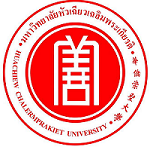Please use this identifier to cite or link to this item:
https://has.hcu.ac.th/jspui/handle/123456789/440| Title: | การศึกษาประสิทธิภาพการบ้าบัดน้าเสียปนเปื้อนสีสังเคราะห์จากโรงงานฟอกย้อม โดยใช้ระบบเยื่อกรองชีวภาพร่วมกับถ่านกัมมันต์ |
| Other Titles: | Study on Treatment Eficiency of Textile Wastewater Containing Synthetic Dye Using Membrane Bioreactor Couple with Activated Carbon |
| Authors: | เทอดพงศ์ ศรีสุขพันธุ์ Thirdpong Srisukphun สุภาภรณ์ ทิวาวรรณ์ Supaporn Tiwawan Huachiew Chalermprakiet University. Faculty of Public and Environmental Health |
| Keywords: | คาร์บอนกัมมันต์ Carbon, Activated น้ำเสีย -- การบำบัด --วิธีทางชีวภาพ Sewage -- Purification -- Biological treatment อุตสาหกรรมฟอกย้อม Textile industry เครื่องปฏิกรณ์แบบเยื่อแผ่น Membrane reactors น้ำเสีย – การบำบัด – การกำจัดสี Sewage -- Purification -- Color removal ระบบเยื่อกรองชีวภาพ Membrane bioreactors |
| Issue Date: | 2015 |
| Publisher: | มหาวิทยาลัยหัวเฉียวเฉลิมพระเกียรติ |
| Abstract: | การวิจัยครั้งนี้เป็นการวิจัยเชิงทดลอง โดยใช้น้ำเสียสังเคราะห์ที่มีลักษณะคล้ายน้ำเสียจากโรงงานฟอกย้อม และใช้ชุดทดลองระดับห้องปฏิบัติการ เพื่อเปรียบเทียบประสิทธิภาพระหว่างระบบ MBR และ MBR-PAC รวมถึงเปรียบเทียบประสิทธิภาพระหว่างการเติม PAC แบบเติมครั้งเดียวและแบบต่อเนื่อง โดยทำการทดลอง 6 ชุดการทดลอง ได้แก่ 1) ไม่เติม PAC 2) เติม PAC แบบเดิมครั้งเดียวความเข้มข้น 1,000 mg/L 3) เติม PAC แบบเติมครั้งเดียว ความเข้มข้น 2,000 mg/L 4) ทำการเติม PAC แบบต่อเนื่องโดยควบคุมอายะ PAC เท่ากับ 100 วัน 5) ทำการเติม PAC แบบต่อเนื่องโดยควบคุมอายุ PAC เท่ากับ 50 วัน 6) ทำการเติม PAC แบบต่อเนื่องโดยควบคุมอายุ PAC เท่ากับ 25 วัน สามารถสรุปผลการทดลองได้ดังนี้ การเติม PAC ช่วยเพิ่มประสิทธิภาพในการบำบัด COD เมื่อเปรียบเทียบระหว่างระบบ MBR และ MBR-PAC เติม 1,000 และ 2,000 mg/L พบว่าประสิทธิภาพการบำบัด COD เท่ากับ 87.42 (± 9.14%, 91,23 (±3.41)% และ 96.51 (±1.59) ตามลำดับ สำหรับการบำบัดสีในการเดินระบบระยะยาวพบว่า การเติม PAC 2,000 mg/L มีประสิทธิภาพ 74.99 (±6.04)% ซึ่งสูงกว่ากรณีเติม PAC 1,000 mg/L และระบบ MBR ที่มีประสิทธิภาพ 52.11 (±6.94)% และ 47.61 (±8.40)% ตามลำดับ การเติม PAC แบบต่อเนื่องโดยควบคุมอายุ PAC เท่ากับ 100, 50 และ 25 วัน ไม่สามารถช่วยเพิ่มประสิทธิภาพการบำบัดเมื่อเปรียบเทียบกับการเติม PAC แบบครั้งเดียว This experimental research is focusing on 1) the comparison of treatment efficiency between MBR and MBR-PAC and 2) the comparison of treatment efficiency between batch dose and continuous dose. The lab-scale experimental unit and synthetic textile wastewater were applied. The experimental conditions consists of 1) MBR without PAC added, 2) MBR-PAC where PAC concentration of 1,000 mg/L was added, 3) MBR-PAC where PAC concentration of 2,000 mg/L was added, 4) PAC was continuously dosed into the reactor with PAC age of 100 days (PAC concentration of 2,000 mg/L), 5) PAC was continuously dosed into the reactor with PAC age of 50 days (PAC concentration of 2,000 mg/L) and 6) PAC was continuously dosed into the reactor with PAC age of 25 days (PAC concentration of 2,000 mg/L). It was found that, the addition of PAC improved COD removal effieicncy. In case of MBR, MBR-PAC (1,000 mg/L) and MBR-PAC (2,000 mg/L), the treatment efficiency were 87.42 (± 9.14%, 91,23 (±3.41)% and 96.51 (±1.59), respectively. Moreover, in long-term, MBR-PAC (2,000 mg/L) performer higher color removal efficiency than MBR-PAC (1,000 mg/L) and MBR. The coolr removel efficiency were 87.42 (± 9.14%, 91,23 (±3.41)% และ 96.51 (±1.59) , 52.11 (±6.94) and 47.61 (±8.40)%. In case of continuous dose with PAC age of 100, 50 and 25 days, the treatment efficiency was similar to the case of MBR-PAC (2,000 mg/L). |
| Description: | วิทยานิพนธ์ (วท.ม.) (การจัดการสิ่งแวดล้อมและความปลอดภัย) -- มหาวิทยาลัยหัวเฉียวเฉลิมพระเกียรติ, 2558. |
| URI: | https://has.hcu.ac.th/jspui/handle/123456789/440 |
| Appears in Collections: | Public and Environmental Health - Theses |
Files in This Item:
| File | Description | Size | Format | |
|---|---|---|---|---|
| Abstract.pdf Restricted Access | 699.54 kB | Adobe PDF | View/Open Request a copy | |
| Tableofcontents.pdf Restricted Access | 330.53 kB | Adobe PDF | View/Open Request a copy | |
| Chapter1.pdf Restricted Access | 312.58 kB | Adobe PDF | View/Open Request a copy | |
| Chapter2.pdf Restricted Access | 833.47 kB | Adobe PDF | View/Open Request a copy | |
| Chapter3.pdf Restricted Access | 519.03 kB | Adobe PDF | View/Open Request a copy | |
| Chapter4.pdf Restricted Access | 508.41 kB | Adobe PDF | View/Open Request a copy | |
| Chapter5.pdf Restricted Access | 387.57 kB | Adobe PDF | View/Open Request a copy | |
| Reference.pdf Restricted Access | 1.5 MB | Adobe PDF | View/Open Request a copy |
Items in DSpace are protected by copyright, with all rights reserved, unless otherwise indicated.
